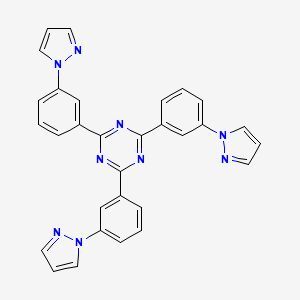3P-T2T
Properties
| Signal Word | Warning |
Product Description
3P-T2T, or 2,4,6-Tris[3-(1H-pyrazol-1-yl)phenyl]-1,3,5-triazine, is a meticulously designed organic compound distinguished by its unique chemical structure. It is engineered to exhibit superior thermal stability and solubility in polar organic solvents, characteristics that make it highly desirable for use in advanced materials and optoelectronic devices. The compound's trispyrazolyltriazine core is surrounded by three phenyl rings substituted with pyrazoles, a configuration that enhances its electron-donating properties. These properties are crucial for applications in organic semiconductors, where they can influence charge transport and recombination processes. Furthermore, 3P-T2T's structure allows for its use in the synthesis of conjugated polymers, which are key components in the development of next-generation electronic and photonic devices.
Application
In practical applications, 3P-T2T serves as a building block for the synthesis of conjugated polymers, playing a critical role in the development of organic semiconductors. Its electron-donating nature facilitates improved charge carrier mobility within these polymers, potentially leading to higher performance in optoelectronic devices such as organic field-effect transistors (OFETs) and organic photovoltaic cells (OPVs). Additionally, its thermal stability and solubility make it suitable for processing techniques that require high temperatures and solvent-based solutions, further expanding its applicability in the fabrication of advanced electronic materials. The compound's versatility in polymer synthesis underscores its importance in advancing the field of organic electronics, where the control over charge transport and device performance is paramount.
Articles:
- Exciplex-Forming Cohost for High Efficiency and High Stability Phosphorescent Organic Light-Emitting Diodes
Publication Date: December 21, 2017
Chun-Jen Shih, Chih-Chien Lee, Ying-Hao Chen, Sajal Biring, Gautham Kumar, Tzu-Hung Yeh, Somaditya Sen, Shun-Wei Liu and Ken-Tsung Wong
https://doi.org/10.1021/acsami.7b15034
- Highly efficient tandem full exciplex orange and warm white OLEDs based on thermally activated delayed fluorescence mechanism
Publication Date: Available online 27 November 2014
Bo Zhao, Tianyou Zhang, Bei Chu, Wenlian Li, Zisheng Su, Yongshi Luo, Ruigang Li, Xingwu Yan, Fangming Jin, Yuan Gao, Hairuo Wu
https://doi.org/10.1016/j.orgel.2014.11.014
- Mixing of Phosphorescent and Exciplex Emission in Efficient Organic Electroluminescent Devices
Publication Date: December 24, 2014
Vladyslav Cherpak, Pavlo Stakhira, Boris Minaev, Gleb Baryshnikov, Evgeniy Stromylo, Igor Helzhynskyy, Marian Chapran, Dmytro Volyniuk, Zenon Hotra, Asta Dabuliene, Ausra Tomkeviciene, Lesya Voznyak, Juozas Vidas Grazulevicius
